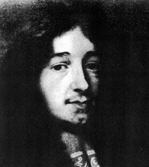Two Huygens and John Donne
Today, a tale of two Huygens and John Donne. The University of Houston's College of Engineering presents this series about the machines that make our civilization run, and the people whose ingenuity created them.
 Christiaan Huygens is well known to anyone who has studied physics. But few people know about his father, Constantijn Huygens. Father and son together take us all the way from the Elizabethan Age to modern physics. The father was born in Holland in 1596. He was wonderfully favored with intelligence and physical grace -- a linguist, athlete, writer, musician and composer.
Christiaan Huygens is well known to anyone who has studied physics. But few people know about his father, Constantijn Huygens. Father and son together take us all the way from the Elizabethan Age to modern physics. The father was born in Holland in 1596. He was wonderfully favored with intelligence and physical grace -- a linguist, athlete, writer, musician and composer.
At twenty-two Constantijn Huygens began a high-profile international life. He studied at Oxford and Cambridge. He played the lute for the same King James who authorized the Bible translation. King James eventually knighted him. He joined diplomatic missions. And he almost killed himself scaling the spire of Strasburg Cathedral.
 In England he made friends of Francis Bacon (who set down the modern scientific method) and the poet John Donne. His respect for Donne colored his life and his son's as well. Constantijn Huygens went on to write plays, prose, and poetry. He honored Donne by translating his poems. If you know Donne's complex style, you know that was no small task, but Huygens was Holland's leading poet.
In England he made friends of Francis Bacon (who set down the modern scientific method) and the poet John Donne. His respect for Donne colored his life and his son's as well. Constantijn Huygens went on to write plays, prose, and poetry. He honored Donne by translating his poems. If you know Donne's complex style, you know that was no small task, but Huygens was Holland's leading poet.
His son Christiaan Huygens was born when Constantijn was 33. Early in his life Christiaan took up optics. He and his brother developed new means for grinding telescope lenses. Out of that they first described the multiple rings of Saturn, and they identified Orion as a nebula. Next Christiaan perfected the pendulum clock, which had been suggested by Galileo and his son. He wrote laws of mechanics that would serve Newton's theory of gravitation.
Christiaan Huygens worked in France until the French started making it hard on Protestants. Then he went back to Holland, where he developed the wave theory of light. He died in 1695, and his last work, published after his death, was a remarkable speculation on the nature and likelihood of extraterrestrial life.
So we go back to Donne's poetry and find it filled with references to the new sciences. Galileo's telescope had just shown that the moon's surface was rough and the sun was spotted. Almost immediately, Donne wrote of the moon and sun, that the crucifixion had "made [God's] footstool crack, and the Sunne winke." To a failed love, he cries, "My constancie I to the planets give ... And all your graces no more use shall have, Than a Sun dyall in a grave."
We find John Donne's scientific themes woven through Christiaan Huygens's work. Twentieth-century quantum mechanics eventually fused Huygens's wave theory of light with Newton's corpuscular theory. When J. Robert Oppenheimer built the atom bomb on those ideas, he named the bomb's test site Trinity. Asked why, the conscience-wracked Oppenheimer once more quoted Donne who had written of the Trinity, "Batter my heart, three person'd God."
The lineage from philosophers like Galileo and Bacon to modern physics is clear enough. But I offer you this remarkable piece of binding tissue: A father and son who read poetry and put it to use.
I'm John Lienhard, at the University of Houston, where we're interested in the way inventive minds work.
(Theme music)
My main sources for this episode were the 1897 and 1970 Encyclopaedia Britannica articles on Constantijn and Christiaan Huygens.
Donne, J., John Donne. (John Hayward, ed.), London: Penguin Books, 1952.
Tollefsen, R., Huygens, Sir Constantijn. The New Grove Dictionary of Music & Musicians, Vol. 8, (Stanley Sadie, ed.) pp. 831-832.